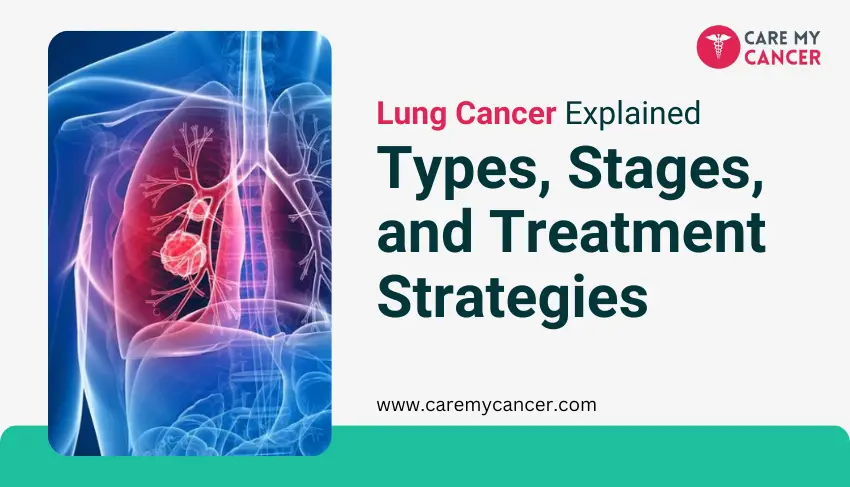Lung cancer is one of the most prevalent and deadly forms of cancer worldwide. It occurs when abnormal cells in the lungs grow uncontrollably, leading to tumors that can interfere with normal lung function. Early diagnosis and proper treatment significantly improve survival rates. In this article, we will discuss the types, stages, and treatment strategies of lung cancer to provide a comprehensive understanding of this disease.
Types of Lung Cancer
Lung cancer is broadly categorized into two main types:
1. Non-Small Cell Lung Cancer (NSCLC)
NSCLC accounts for about 85% of lung cancer cases and includes three subtypes:
- Adenocarcinoma: The most common type, usually found in people who smoke or have smoked in the past. It originates in mucus-secreting cells and can occur in non-smokers as well.
- Squamous Cell Carcinoma: Often linked to smoking, this type forms in the lining of the bronchial tubes.
- Large Cell Carcinoma: A rare and aggressive form that can appear in any part of the lung.
2. Small Cell Lung Cancer (SCLC)
SCLC is less common but more aggressive, accounting for about 15% of lung cancers. It spreads rapidly and is usually linked to heavy smoking.
Stages of Lung Cancer
Lung cancer is staged to determine the severity and spread of the disease, guiding treatment decisions.
Non-Small Cell Lung Cancer (NSCLC) Stages
- Stage 0: Abnormal cells are present but haven’t spread.
- Stage I: Cancer is localized to the lung and hasn’t spread.
- Stage II: Tumor has spread to nearby lymph nodes.
- Stage III: Cancer has spread to surrounding tissues or organs.
- Stage IV: Cancer has metastasized to distant organs.
Small Cell Lung Cancer (SCLC) Stages
- Limited Stage: Cancer is confined to one lung and nearby lymph nodes.
- Extensive Stage: Cancer has spread to other parts of the body.
Causes and Risk Factors
Several factors contribute to lung cancer development, including:
- Smoking: The leading cause, responsible for nearly 90% of cases.
- Secondhand Smoke: Prolonged exposure increases risk.
- Radon Gas Exposure: A natural radioactive gas that can accumulate in homes.
- Occupational Hazards: Asbestos, arsenic, and diesel exhaust exposure increase the risk.
- Genetics: Family history can play a role.
Symptoms of Lung Cancer
Lung cancer symptoms often appear in later stages and include:
- Persistent cough
- Coughing up blood
- Shortness of breath
- Chest pain
- Unexplained weight loss
- Fatigue
Diagnosis of Lung Cancer
Early diagnosis is critical for effective treatment. Common diagnostic methods include:
- Imaging Tests: X-rays, CT scans, and PET scans to detect tumors.
- Biopsy: Extracting a tissue sample for lab testing.
- Sputum Cytology: Examining mucus from the lungs for cancer cells.
- Bronchoscopy: Using a camera to view lung airways.
Treatment Strategies
Treatment depends on the cancer type, stage, and overall health of the patient. The main treatment options include:
Surgery
Best for early-stage NSCLC, where a portion or the entire lung is removed to eliminate cancerous cells.
Radiation Therapy
Uses high-energy beams to kill cancer cells. Often used when surgery isn’t an option or to shrink tumors before surgery.
Chemotherapy
Drugs are used to kill cancer cells throughout the body. It’s often recommended for advanced lung cancer or post-surgery to eliminate remaining cells.
Targeted Therapy
Designed for specific genetic mutations in cancer cells, targeted drugs block cancer growth at a molecular level.
Immunotherapy
Boosts the immune system to recognize and attack cancer cells, offering a promising option for some lung cancer patients.
Palliative Care
For advanced-stage patients, palliative care focuses on improving quality of life and managing symptoms.
Prevention and Lifestyle Changes
While not all lung cancers are preventable, adopting a healthier lifestyle can reduce the risk:
- Quit Smoking: The most effective way to prevent lung cancer.
- Avoid Secondhand Smoke: Stay away from smokers.
- Test for Radon: Ensure home safety.
- Wear Protective Gear: If working in high-risk environments.
- Maintain a Healthy Diet: Antioxidant-rich foods help boost immunity.
- Regular Health Screenings: Early detection improves survival rates.
Conclusion
Lung cancer remains a serious global health challenge, but advancements in early detection and treatment provide hope. Understanding the types, stages, and treatment strategies can empower individuals to make informed decisions about their health. If you or a loved one are at risk, seek medical advice and take preventive measures to safeguard your well-being.
Book an Appointment With Dr. Kamlesh Verma (Best Oncologist in Lucknow)

